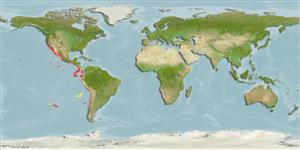Klassifizierung / Names
Namen | Synonyme | Catalog of Fishes(Gattung, Arten) | ITIS | CoL | WoRMS | Cloffa
Holocephali (Chimären, Seekatzen) (chimaeras) >
Chimaeriformes (Chimaeras) >
Chimaeridae (Shortnose chimaeras or ratfishes)
Etymology: Hydrolagus: hydro-, combining form of hydor (Gr.), water; lagos (Gr.), hare, i.e., “water rabbit,” probably referring to three pairs of tooth plates, which tend to protrude from the mouth like a rabbit’s incisors. (See ETYFish); melanophasma: melanos (Gr.), black, referring to color in life; phasma (Gr.), ghost or specter, alluding to the vernacular “ghostshark” (literally, a black ghost). (See ETYFish).
Environment: milieu / climate zone / depth range / distribution range
Ökologie
seewasser bathydemersal; tiefenbereich 2 - 1720 m (Ref. 93040), usually 565 - 1720 m (Ref. 93040). Subtropical; 35°N - 40°S, 125°W - 70°W (Ref. 93040)
Eastern Pacific Ocean: From Baja California, Mexico to Validivia, Chile.
Size / Gewicht / Alter
Maturity: Lm ? range ? - ? cm
Max length : 120 cm TL Männchen/unbestimmt; (Ref. 82286)
Kurzbeschreibung
Morphologie | Morphometrie
A species of the genus Hydrolagus based on the absence of an anal fin. Hydrolagus
melanophasma sp. nov. is distinguished from other chimaeroids by a blunt snout with minimal sloping from the orbit to the snout tip, a large slightly curved dorsal fin spine (25.9 % BDL) extending beyond first dorsal fin apex, and a long second dorsal fin (77.3–81.1% BDL) of uniform height throughout. The pectoral fins are large, reaching beyond the pelvic fin insertion when laid flat, trifid claspers forked for 27–27.8% of the total clasper length and the preopercular and oral lateral line canals branch separately or together from the infraorbital canal. Coloration after preservation is a uniform black with no distinct mottling or markings (Ref. 82286).
Life cycle and mating behavior
Geschlechtsreife | Fortpflanzung | Ablaichen | Eier | Fecundity | Larven
James, K.C., D.A. Ebert, D.J. Long and D.A. Didier, 2009. A new species of chimaera, Hydrolagus melanophasma sp. nov. (Chondrichthyes: Chimaeriformes: Chimaeridae), from the eastern North Pacific. Zootaxa 2218:59-68. (Ref. 82286)
IUCN Rote Liste Status (Ref. 130435)
Bedrohung für Menschen
Harmless
Nutzung durch Menschen
Mehr Information
NamenSynonymeMetabolismusRäuberÖkotoxikologieFortpflanzungGeschlechtsreifeAblaichenSpawning aggregationFecundityEierEientwicklung
Alter/GrößeWachstumLänge-GewichtLänge-LängeLängenhäufigkeitenMorphometrieMorphologieLarvenLarven Pop.Dyn.RekrutierungDichteBRUVS
ReferenzenAquakulturAquakultur ProfilZuchtlinienGenetikElectrophoresesVererbbarkeitKrankheitenVerarbeitungNutrientsMass conversion
PartnerBilderStamps, Coins Misc.LauteCiguateraGeschwindigkeitSchwimmstilKiemenoberflächeOtolithsGehirngrößeSehfähigkeit
Tools
Zusatzinformationen
Download XML
Internet Quellen
Estimates based on models
Preferred temperature (Ref.
123201): 2.6 - 6.5, mean 3.9 °C (based on 154 cells).
Phylogenetic diversity index (Ref.
82804): PD
50 = 0.5000 [Uniqueness, from 0.5 = low to 2.0 = high].
Bayesian length-weight: a=0.00282 (0.00118 - 0.00673), b=3.10 (2.89 - 3.31), in cm total length, based on LWR estimates for this (Sub)family-body shape (Ref.
93245).
Trophic level (Ref.
69278): 4.0 ±0.6 se; based on size and trophs of closest relatives
Widerstandsfähigkeit (Ref.
120179): sehr niedrig, Verdopplung der Population dauert mehr als 14 Jahre. (Preliminary K or Fecundity.).
Fishing Vulnerability (Ref.
59153): High to very high vulnerability (72 of 100).
Nutrients (Ref.
124155): Calcium = 17.4 [4.7, 51.6] mg/100g; Iron = 0.615 [0.214, 2.960] mg/100g; Protein = 16.4 [10.7, 19.5] %; Omega3 = 0.285 [0.125, 0.653] g/100g; Selenium = 54.7 [14.2, 174.3] μg/100g; VitaminA = 9.72 [2.86, 35.69] μg/100g; Zinc = 0.566 [0.279, 1.093] mg/100g (wet weight);
